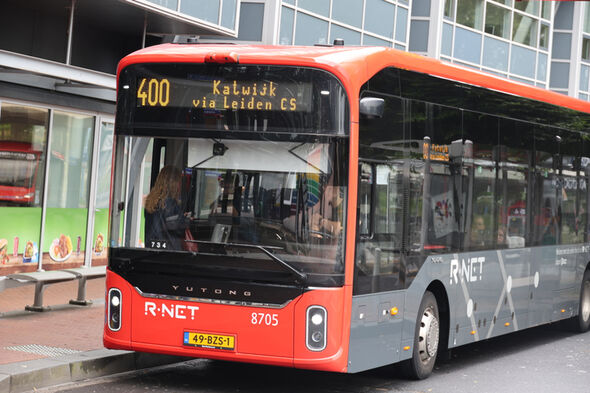
Kill switches: a new way of waging war
Exploding pagers in Libanon were just one example: countless appliances can be manipulated from afar
Meanwhile, there is already evidence found of Chinese kill switches in devices like wind turbines, solar panels, and buses. These are pieces of hardware that allow the manufacturer to disable or disrupt the device. Are we surrounded by ticking time bombs?
Kill switches are like backdoors in electrical equipment. They can remotely disable or disrupt the device on command. The switches themselves aren't new; they've been around for years. Consider the discussion about the use of Huawei equipment in mobile phone networks. But the potential consequences are new and significant due to the Internet of Things (IoT), which we'll discuss later.
To understand what kill switches can do, it's helpful to look at Israel's pager attack in Lebanon. Specially manipulated software was placed in pagers ordered by the militant group Hezbollah in Taiwan. Communication with this software, combined with explosives, would cause them to detonate at a time determined by the Mossaad (Israeli intelligence agency).
The New York Times reported at the time that the pagers had already been tampered with before they arrived in Lebanon. The Mossaad was allegedly responsible for this and had placed small quantities of explosives in five thousand pagers. On September 17, 2024, all those pagers exploded simultaneously due to a coded message received by all of them. Nine people were killed and nearly three thousand wounded across Lebanon, with an unknown number injured in Syria.
Detection
Figures on the number of kill switches are hard to come by. Experts we spoke with hesitate to estimate the number of kill switches in existence. Detecting backdoors in the hardware is very difficult. This is because chips are extremely complex. They contain billions of components, and there's no test protocol that can detect hidden behavior even if it's subtle. Therefore, incorporating subtle behavior seems to be the most successful way to stay under the radar.
Take a solar panel. You can build something into the hardware that checks for a specific code that instructs it to stop working. A clock can also be built in, and if a certain time elapses, the system shuts down. "That could be a form of warfare if you do this on a massive scale and thereby unbalance the electricity grid," says Jan Friso Groote, professor of Formal Systems Analysis. "The fact that a kill switch is so difficult to find also makes it difficult to defend against."
Potential impact
"In May of this year, there was a stir due to a Reuters report about the massive number of kill switches in Chinese-made power electronics converters – which are present in almost the entire market for solar panels and battery systems," says Professor Guus Pemen, head of the Electrical Energy Systems research group. These converters are used worldwide, and a coordinated activation of the kill switch could lead to a large-scale disruption of the electricity supply. The electricity grid cannot withstand this and shuts down, potentially damaging cables. If a country deliberately tries to do this, it can strategically weaken another country.
Because China has the world's largest production capacity and is the second-largest global player in terms of GDP, the potential impact of its kill switches is also significant. The Asian country currently holds 90 percent of the production capacity for the battery market and 60 percent of the production capacity for the wind turbine market.
Besides its energy production business, China also manufactures many buses that Europe eagerly consumes. Chinese buses are in operation in Denmark, Norway, and the Netherlands, among other countries. Yutong buses made headlines last week because kill switches were also found in them. The manufacturer can disable the buses with a software update.
According to research by the Norwegian bus company Ruter, published at the end of October, the bus contains a SIM card that connects to a Romanian provider for the battery monitoring system. However, Ruter added that there is "barely any integration" with other systems in the bus. Therefore, they believe removing the SIM card would be the solution to breaking China's power. But experts at TU/e believe that being 100 percent certain that no other kill switches are present is virtually impossible because the chips are so complex.
Transdev, the parent company of Connexxion and also active in Eindhoven and the surrounding area, is conducting additional research on its own buses to determine if they also contain kill switches. The transport company stated in the Telegraaf newspaper that it "has agreed with manufacturer Yutong that such systems are not permitted."
Chaos
Pemen believes the likelihood of a large-scale, coordinated act of sabotage is small. “Our electricity system is robust, and grid operators are reasonably aware of dangerous scenarios. But there is a serious risk of localized power outages in the event of a massive shutdown of solar farms.”
Groote, like Pemen, believes we shouldn't immediately worry about a scenario similar to the pagers in Lebanon in the Netherlands. However, he does see the risk of secretly embedded behavior in remotely controlled devices: it could create chaos. “Imagine if all modern cars suddenly took off at top speed. There would be so much unrest that it would be the ideal moment to launch an attack. You could militarily destabilize a country.”
He draws a comparison with the past. Back then, dikes were bombed, everything was flooded, and all attention had to be focused on that. "Now you can use technical devices to do that work for you."
Pemen does see other undesirable side effects of the threat. Reports about the existence of kill switches and the potential impact of their use are leading to increased tensions in society. "It can damage confidence in the systems in question and thus the market. Insurance premiums could also rise."
Geopolitical ammunition
Installing kill switches isn't unique to China, but it's the topic of most publications. The AIVD (General Intelligence and Security Service) has been asked whether kill switches are also being installed in the Netherlands or Europe.
The intelligence service states that it does not maintain a database of products containing a kill switch. Furthermore, the AIVD does not investigate products that may contain a kill switch, regardless of their country of origin. This is not part of their remit.
If the AIVD becomes aware of a vulnerability in a system or product, they can inform users about the risks based on this information.
Local production
You might wonder why we don't simply produce chips here if it's so difficult to check the hardware for kill switches. That has to do with the costs and is a choice from the past. Yes, we have ASML around the corner, which makes the chip machines. But Europe shifted chip production to China decades ago because labor costs were much lower there. And that has given China not only market share but also considerable expertise and, consequently, power.
Assistant professor in the Internet of Things, Savio Sciancalepore, points out that if we bring production back to Europe, we must be vigilant about supply chain security. A product often contains hundreds of components that are purchased from suppliers, who in turn purchase from suppliers, and so on. It's difficult to be certain who supplied the components throughout the entire chain. Sciancalepore is researching how to make this chain as secure as possible.
Hacking a car
Several programmers discovered that you can hack a modern car quite easily. They did this with a Jeep, but the concept was applicable to cars that work with a Uconnect feature or similar. This is a computer in the dashboard, connected to the internet. Through this system, you can request information, but also issue commands.
Requesting information might include asking where the car is going using the GPS function. Those give you more information on where the car is, but do not influence its state. Commands however have a direct impact on the car's state (and possibly also that of the driver). For example, a hacker could turn up the music incredibly loud, take over steering or acceleration, or even lock the brakes. To exploit this, you first have to hack into the mobile network and then send canned messages (a kind of template message). With these, you can take over the system.
In the video, it starts "innocently" with turning on the The air conditioning, washer, and windshield wipers are all working. This already distracts the driver. Turning up the music extremely loudly further distracts. Combined with the poor visibility caused by the washer, this can be dangerous on the road. But then the hackers interfere with the engine's operation; the driver suddenly can no longer accelerate. This is very dangerous, for example, on a busy highway or during an overtaking maneuver. Later, they lock the brakes, and the driver unintentionally drives into a drained ditch.
Chrysler, the manufacturer of Jeep, rolled out a patch after these discoveries were shared with them. This is a type of update specifically designed to fix a vulnerability. Nevertheless, products connected to the internet remain at risk of being hacked. The video was released a while ago, but warnings about the risk of car hacks have continued this year.
The AIVD spokesperson stated that many products have this option to stop the process built in. Hardware and/or software is integrated that can intervene for safety reasons, for example. Think of automatic emergency braking (AEB) and lane control in cars. It's also always possible that software vulnerabilities exist. Most of these are errors made during development. While these aren't always intentional, they can still be exploited.
Internet of Things
The Internet of Things (IoT) is the process of connecting physical objects, such as appliances and vehicles, to the internet. These "smart" objects are equipped with sensors, software, and other technology to collect and share data with other devices and systems. Examples include a smartwatch that shares step counts with your phone or a smart thermostat that remotely controls the temperature.
IoT has become increasingly popular over the past ten to fifteen years. An estimated 50 billion (!) devices are now connected to the internet and can thus be remotely controlled. This is not only convenient for you as a user, but also poses a risk of unwanted interference. "I'm convinced that Russia, for example, is using the security cameras in Ukraine to monitor their surroundings, and the same is likely true for the other way around," says Groote.
The Netherlands has millions of cameras that could likely be used for this purpose. 1.2 million people have a smart doorbell connected to the internet. And roughly the same number of people have other cameras in and/or around their home. Other household appliances are also connected to the internet these days. This gives the manufacturer access to the product.
Sciancalepore emphasizes that this access is an example of dual use. A manufacturer can provide a patch to their product to quickly address a vulnerability. But they can also send a message to the device to disable itself, for example, as can happen with kill switches.
International relations
International relations have changed rapidly in recent years, and the relative calm after the Cold War is over. Groote finds it regrettable to see that this is also impacting science.
"Until a few years ago, we had conferences in which Russian researchers also participated. And we collaborated intensively with Chinese universities. We were truly on our way to a world where at least the scientific community was united." The trust that was felt until recently has given way to distrust and rifts.
Weighing the risks
“Now the law of the strongest applies,” says Groote. “And that includes the installation of kill switches.” He believes that influence from Russia and China has significantly affected citizens’ attitudes, both here and there. “Extreme leaders like Trump have also gained power as a result. If such people want to exert their influence, kill switches can be an easy tool to use.”
Sciancalepore acknowledges the dangers but remains realistic. “If you want to avoid any risk of harmful misuse of kill switches, you shouldn’t use anything connected to the internet.” With his own smartphone on the table, he knows that almost no one lives like that. “With every connection, you hopefully make a careful trade-off between the benefits and the risks.”
This article was translated using AI-assisted tools and reviewed by an editor.






Discussion